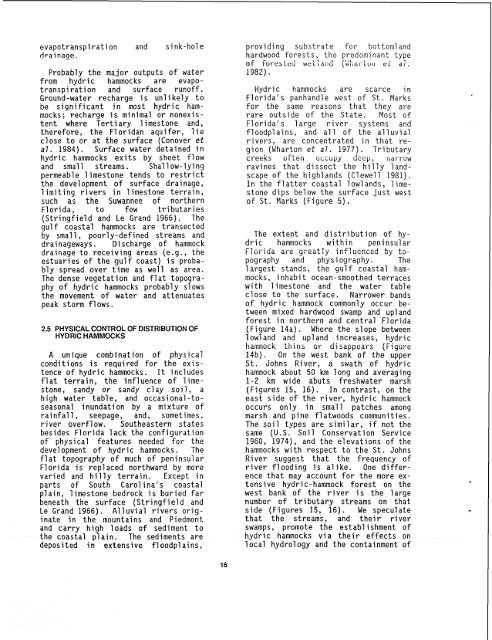The Ecology of Hydric Hammocks - USGS National Wetlands ...
The Ecology of Hydric Hammocks - USGS National Wetlands ...
The Ecology of Hydric Hammocks - USGS National Wetlands ...
You also want an ePaper? Increase the reach of your titles
YUMPU automatically turns print PDFs into web optimized ePapers that Google loves.
evapotranspiration and sink-hol edrainage.Probably the major outputs <strong>of</strong> waterfrom hydri c hammocks are evapotranspirationand surface run<strong>of</strong>f.Ground-water recharge is unlikely tobe significant in most hydric hammocks;recharge is minimal or nonexistentwhere Tertiary limestone and,therefore, the Floridan aquifer, lieclose to or at the surface (Conover eta7. 1984). Surface water detained inhydric hammocks exits by sheet flowand small streams. Shall ow-lyingpermeable 1 imestone tends to restrictthe development <strong>of</strong> surface drainage,1 imi ting rivers in 1 imestone terrain,such as the Suwannee <strong>of</strong> northernFlorida, to few tributaries(Stringfield and Le Grand 1966). <strong>The</strong>gulf coastal hammocks are transectedby small, poorly-defined streams anddrainageways. Discharge <strong>of</strong> hammockdrainage to receiving areas (e-g., theestuaries <strong>of</strong> the gulf coast) is probablyspread over time as well as area.<strong>The</strong> dense vegetation and flat topography<strong>of</strong> hydric hammocks probably slowsthe movement <strong>of</strong> water and attenuatespeak storm flows.2.5 PHYSICAL CONTROL OF DISTRIBUTION OFHYDRIC HAMMOCKSA unique combination <strong>of</strong> physicalconditions is required for the existence<strong>of</strong> hydric hammocks. It includesflat terrain, the influence <strong>of</strong> limestone,sandy or sandy clay soil, ahigh water table, and occasional-toseasonalinundation by a mixture <strong>of</strong>rainfall, seepage, and, sometimes,river overflow. Southeastern statesbesides Florida 1 ack the configuration<strong>of</strong> physical features needed for thedevelopment <strong>of</strong> hydric hammocks. <strong>The</strong>flat topography <strong>of</strong> much <strong>of</strong> peninsularFlorida is rep1 aced northward by morevaried and hilly terrain. Except inparts <strong>of</strong> South Carolina's coastalplain, limestone bedrock is buried farbeneath the surface (Stringfield andLe Grand 1966). Alluvial rivers originatein the mountains and Piedmontand carry high loads <strong>of</strong> sediment tothe coastal plain. <strong>The</strong> sediments aredeposited in extensive floodplains,providing substrate for bottomlandhardwood forests, the predominant type<strong>of</strong> foresled w~t:~iLd {;;;&J ~ V I I el ai.1982).<strong>Hydric</strong> hammocks are scarce inFlorida's panhandle west <strong>of</strong> St. Marksfor the same reasons that they arerare outside <strong>of</strong> the State. Most <strong>of</strong>Florida's large river systems andfloodplains, and all <strong>of</strong> the alluvialrivers, are concentrated in that region(Wharton et al. 1977). Tributarycreeks <strong>of</strong>ten O~taFy deep, i3drrCWravines that dissect the hilly landscape<strong>of</strong> the highlands (Clewell 1981).In the flatter coastal lowlands, limestonedips below the surface just west<strong>of</strong> St. Marks (Figure 5).<strong>The</strong> extent and distribution <strong>of</strong> hydrichammocks within peninsularFlorida are greatly influenced by topographyand physiography. <strong>The</strong>1 argest stands, the gulf coastal hammocks,inhabit ocean-smoothed terraceswith limestone and the water tableclose to the surface. Narrower bands<strong>of</strong> hydric hammock commonly occur betweenmixed hardwood swamp and uplandforest in northern and central Florida(Figure 14a). Where the slope between1 owl and and up1 and increases, hydri chammock thins or disappears (Figure14b). On the west bank <strong>of</strong> the upperSt. Johns River, a swath <strong>of</strong> hydrichammock about 50 km long and averaging1-2 km wide abuts freshwater marsh(Figures 15, 16). In contrast, on theeast side cf the river, hydric hammockoccurs only in small patches amongmarsh and pine fl atwoods communities.<strong>The</strong> soil types are similar, if not thesame (U.S. Soil Conservation Service1960, 1974), and the elevations <strong>of</strong> thehammocks with respect to the St. JohnsRiver suggest that the frequency <strong>of</strong>river flooding is alike. One differencethat may account for the more extensivehydric-hammock forest on thewest bank <strong>of</strong> the river is the largenumber <strong>of</strong> tributary streams on thatside (Figures 15, 16). We speculatethat the streams, and their riverswamps, promote the establ i shment <strong>of</strong>hydric hammocks via their effects on1 ocal hydro1 ogy and the containment <strong>of</strong>

















